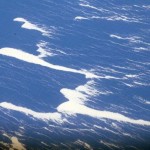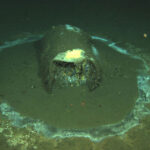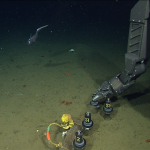Two interesting new articles are available from the American Geophysical Union publications. The first requires a brief ocean geography lesson, the second documents newly identified features off the Pacific coast of Mexico.
Walczowski, W and J Piechura. 2007. Pathways of the Greenland Sea warming. Geophysical Research Letters. http://www.agu.org/pubs/crossref/2007/2007GL029974.shtml
The Fram Strait between Greenland and Svalbard Islands is the only deep-water connection between the Arctic Ocean and the world ocean, so this high latitude pass is critically important for heat, mass, and salt exchange. The West Spitsbergen Current is one of two currents through the Fram Strait. WSC is a poleward flowing northern extension of the Norwegian Atlantic Current. The East Greenland Current (ECG) flows southward bringing cool, fresh Arctic Water to the Atlantic.
New research from the Polish Institute for Oceanology indicates the temperature and salinity at the core of the Atlantic water has reached the highest levels ever observed. They attribute the warming to the northward advection of large mesoscale eddies within the western branch of the WSC in summer 2005. The changes may have large impacts on the Arctic Ocean climate and ecosystem.
Zamudio, L; Hurlburt, H E.; Metzger, E. J.; Tilburg, C. E. 2007. Tropical wave-induced oceanic eddies at Cabo Corrientes and the Maria Islands, Mexico J. Geophys. Res., Vol. 112, No. C5, C05048 . http://dx.doi.org/10.1029/2006JC004018
Satellite oceanographers using the 1/16th degree Navy Layered Ocean Model detected interannual variability in a system of anticyclonic (downwelling) eddies off the Mexican west coast near Cabo Corrientes (Maria Islands). The eddies are generated by coastal trapped tropical waves (CTWs) originating in the equatorial Pacific, acting to intensify local wind driven currents around abrupt topography like capes in the coastline. The CTW’s produced and average of 2.5 eddies per year between 1979 and 2001, with more eddies in an El Nino year.





